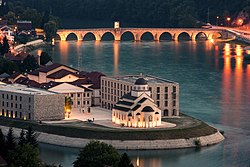Mehmed Paša Sokolović Bridge
Mehmed Paša Sokolović Bridge | |
|---|---|
 | |
| Coordinates | 43°46′57″N 19°17′17″E / 43.782446°N 19.287963°E |
| Crosses | Drina River |
| Locale | Višegrad, Republika Srpska, Bosnia and Herzegovina |
| Official name | Most Mehmed-paše Sokolovića |
| Heritage status | |
| Official name | Mehmed paša Sokolovic Bridge, the historical monument |
| Type | Category 0 cultural-historical and natural monument |
| Criteria | A, B, C i.ii.iii.iv.v.vi., D iii.iv., E iii.v., F i.ii.iii., G i.ii.iii.iv.v.vi., H ii.iii. |
| Designated | 4 March 2003 (session no.-) |
| Reference no. | 769 |
| Decision no. | 08.2-6-101/03-5 |
| Has parts | - |
| List | |
| Characteristics | |
| Design | Arch |
| Material | Limestone |
| Total length | 179.5 metres |
| Traversable? | pedestrian |
| No. of spans | 11 |
| History | |
| Architect | Mimar Sinan |
| Constructed by | Sokollu Mehmed Pasha |
| Opened | 1577 |
| Official name | Mehmed Paša Sokolović Bridge in Višegrad |
| Type | Cultural |
| Criteria | ii, iv |
| Designated | 2007 (31st session) |
| Reference no. | 1260 |
| Region | Europe and North America |
| Location | |
 | |
The Mehmed Paša Sokolović Bridge (Serbian: Мост Мехмед-паше Соколовића, romanized: Most Mehmed-paša Sokolovića) is a historic bridge in Višegrad, over the Drina River in eastern Bosnia and Herzegovina part of the Republika Srpska entity. It was completed in 1577 by the Ottoman court architect Mimar Sinan on the order of the Grand Vizier Mehmed Paša Sokolović.[1] In 2003 bridge was included into the List of National Monuments of Bosnia and Herzegovina by KONS,[2] and UNESCO inclusion into the World Heritage List followed in 2007.
Characteristics[edit]
It is characteristic of the apogee of Turkish monumental architecture and civil engineering. It numbers 11 masonry arches, with spans of 11 to 15 meters, and an access ramp at right angles with four arches on the left bank of the river.
The 179.5-meter-long (589 ft) bridge is a representative masterpiece of Mimar Sinan, one of the greatest architects and engineers of the classical Ottoman period and a contemporary of the Italian Renaissance, with which his work can be compared. The UNESCO summary states: The unique elegance of proportion and monumental nobility of the property as a whole bear witness to the greatness of this style of architecture.[3]
History[edit]

The Višegrad Bridge was commissioned by Grand Vizier Mehmed Pasha Sokolović, who exercised power over a long period at the summit of the Ottoman Empire during the reign of three sultans as a tribute to his native region and a symbol of trade and prosperity. Construction of the bridge took place between 1571 and 1577. Major renovations of the bridge have taken place in 1664, 1875, 1911, 1940 and 1950–52. Three of its 11 arches were destroyed during World War I and five were damaged during World War II but subsequently restored.[4]

Renovation[edit]
The bridge received UNESCO World Heritage Listing in 2007.
The Turkish International Co-operation and Development Agency (TIKA) provided 3.5 million euros for the restoration of the Mehmed Paša Sokolović Bridge. Representatives of TIKA, the BiH Commission for Co-operation with UNESCO, the Republika Srpska Cultural Ministry and the Višegrad municipality signed an agreement to renovate the bridge on 19 April 2010.[5]

In literature[edit]
The bridge is widely known because of the book The Bridge on the Drina (1945) written by Yugoslav writer Ivo Andrić, Nobel Prize–winning author.[4][6]
See also[edit]
References[edit]
- ^ Mehmed Paša Sokolović Bridge at Structurae. Retrieved 15 April 2017.
- ^ "Mehmed paša Sokolovic Bridge, the historical monument". old.kons.gov.ba. Sarajevo: Commision to preserve national monuments. 4 March 2003. Retrieved 31 May 2024.
- ^ "UNESCO World Heritage Centre - Bosnian Bridge among five new sites inscribed on UNESCO's World Heritage List this evening". Whc.unesco.org. Retrieved 14 July 2017.
- ^ a b "Mehmed-Pasha Sokolovic Bridge". Archived from the original on 2 July 2007. Retrieved 14 July 2017.
- ^ "Culture and Sports: Turkish agency sponsors repairs to Ottoman bridge". SETimes.com. Retrieved 15 April 2017.
- ^ Wayne S. Vucinich, ed. (1995). "Ivo Andrić Revisited: The Bridge Still Stands" (PDF). Division of International and Area Studies, University of California, Berkeley. Archived (PDF) from the original on 27 May 2020.
Relevant literature[edit]
- Ševo, Ljiljana. "Stari Višegradski most u narodnoj tradiciji, putopisima i umjetnosti." Baština II (2006): 173-191.
External links[edit]
 Media related to Mehmed Paša Sokolović Bridge in Višegrad at Wikimedia Commons
Media related to Mehmed Paša Sokolović Bridge in Višegrad at Wikimedia Commons- Mehmed Paša Sokolović Bridge, visegradturizam.com
- Mehmed Paša Sokolović Bridge, official promo video 2019, youtube.com
- UNESCO listing of Mehmed Paša Sokolović Bridge in Višegrad, whc.unesco.org
- Ottoman bridges in Bosnia and Herzegovina
- Deck arch bridges
- Architecture in Bosnia and Herzegovina
- World Heritage Sites in Bosnia and Herzegovina
- Bridges completed in 1577
- Višegrad
- Mimar Sinan buildings
- Buildings and structures in Republika Srpska
- 1577 establishments in Europe
- Medieval Bosnia and Herzegovina architecture
